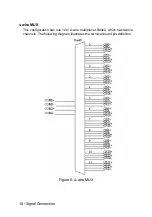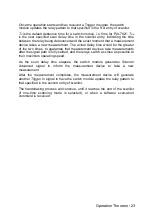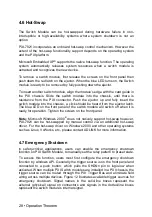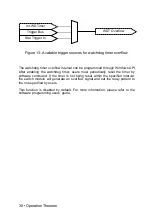
Operation Theorem
•
29
Shutdown Trigger
Figure 12: Available trigger sources for emergency shutdown
The default relay pattern for emergency shutdown is All-Off on PXI-7921; users
can change the pattern by Windows API.
Upon receiving the emergency shutdown trigger, the Switch Module enters
shutdown mode, and the relay pattern is switched to the preset state. If the
Switch Module is in
Auto-scan
mode, the updating process would be stopped
immediately; in
Direct Update
mode where the switch module will not accept
any further update instructions.
To leave emergency shutdown mode, users must call adlSwitch_Recovery in
Windows API. The relay pattern would stay the same as they would in the
emergency shutdown mode, and the scanlist (if set) being rewound to the first
entry.
Note the auxiliary digital I/O function pin AUX2 shares the SHDNn pin; driving
AUX2 to logic-low while the emergency shutdown function is enabled. It will
falsely trigger the Switch Module to enter shutdown mode.
This function is disabled by default. For more information, please refer to the
software programming users’ guide.
4.8 Watchdog Timer
In safety-critical applications, users can enable the watchdog timer function on
PXI Switch Module to automatically set the relay pattern to preset state, in case
the operating system or PXI controller crashes.
To access this function, users must first configure the watchdog timer overflow
trigger source by windows API. Generally the trigger source would come from
the onboard 32-bit watchdog timer. When multiple ADLINK PXI Switch modules
are installed in a PXI chassis, the trigger source can be routed through the PXI
Trigger Bus and eliminate redundant watchdog timer setting on multiple devices.
Figure 13 illustrates the available trigger sources for watchdog timer overflow.
Signal names in the solid-line boxes represent the external (physical) signal on
connectors and signals in the dotted-line boxes represent the switch module’s
internal signal.
AUX2/SHDNn
Trigger Bus
Star Trigger In



































